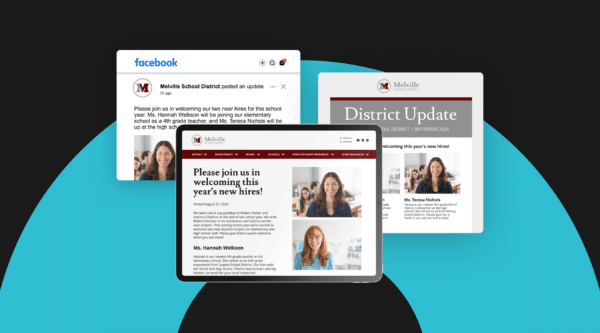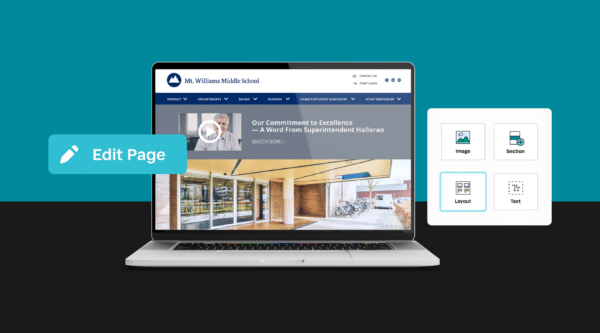

Effective communication is crucial to any organization, and schools are no different. With a comprehensive communications plan, you’ll be able to promote your school to families and the community, connect with current students, attract future ones, and even successfully engage staff members.
A solid, actionable plan is critical for school communications success, but things are moving pretty fast these days for even the savviest communicators.
An up-to-date school communications plan will help you utilize the increasing array of tools available to today’s school communicators. Given the variety of kinds of information and the modern channels for delivering school info, planning and allocating resources has never been more important.
To begin, make sure your current communications plan is not suffering.
From crisis communications, to urgent & time-sensitive matters, to the lunch menu postings, to developing a speakers bureau for your school, a plan can make your life a lot easier.
How your school handles your website, social media, emergency notifications, and simple school newsletters—all these facets should come into play in one comprehensive communications plan. Even mundane communications such as posting scores of athletic events and keeping your school calendar current can be addressed in a comprehensive school communications plan.
Follow these three basic steps to create a communications plan that works well for your school. After considering these foundational steps, refer to this comprehensive School Communications Planning Guide to begin outlining specific strategies and goals using today’s modern communications channels.
Put the “Strategic” in Your School Communications
Know Your Mission
No more status quo. Examine your school’s strengths and weaknesses. What makes families decide to enroll their children in your school? Why do they pass over yours to go elsewhere?
Articulate your school mission on well-founded input from key school administrators and what you know about your school—and where you want it to be. The National School Public Relations Association (NSPRA) has some excellent resources for this stage of your planning, including how to conduct a communications audit for your school or district and a sample outline of a strategic communications plan.
Know ALL your audiences
You should also consider your current communications with staff, families, and students. Are there any disconnects you need to eliminate? Have there been misunderstandings because event information isn’t transmitted as smoothly as it could be between staff and parents? How can you better engage staff, families, and students at your school?
Surveys are excellent ways to both gather key stakeholder concerns and show that you care. Perhaps your communication with staff is excellent, but there have been issues with enrollment. Are you reaching prospective students effectively? Maybe you’re finding it challenging to connect with families regularly. Identify the main target groups that you need to communicate with more effectively and create your school communications plan around them.
Use These Key Channels to Reach Your Audiences
This is really about choosing the right medium. Where is your target audience and how can you reach them? The internet, of course, is one of the most important places you should be active. A school website and social media are wonderful ways to reach out to staff, parents, and especially students.
The Must-Have Channels for Your Planning:
- District and school websites
- Mobile app
- Notifications and alerts
- Social media
- Blog
- Video
- Podcasts
If your website hasn’t been updated recently, now is the time to consider how you can maintain it regularly and ensure the content and design are engaging. The article, 5 Tips for Great School Website Design, has ideas on making the design of your school website top-notch. Your website should be super easy to navigate, look great, and frequently accessed pages quick to access for each of your key user groups—teachers, families, and students.
Notification systems, mobile apps, emails, social media, blogs and videos are the other channels critical to reaching all your stakeholders. Unifying all these channels can be a challenge, but it’s important these channels are integrated for the best reach.
This article on using today’s modern communications channels is a good reference as you set out on planning
Use Teamwork & Technology
Once you have chosen how you will engage target audiences, it’s time to craft your message and gather the right content. What do you want your audience to know? How can you best use these channels to engage them and get them to keep coming back to your channels? Who’s going to do all the legwork to find and create all the content?
Surround yourself with communications lieutenants who can serve as the eyes and ears of the vast “field” of building-level communications opportunities. These designees can be principals, admins, teachers, or any staff member who can serve as a champion for school communications.
Use technology to solicit ideas: a dedicated email address (goodnews@mapledaleschool.edu); submission forms on your website; and your school’s social media channels are great ways to gather great ideas.
How to share school information has changed dramatically in recent years, but what hasn’t changed are the kinds of information that need to be shared.
The Four Key Content Hubs to Cover:
- Crisis communications
- Internal communications
- Media and community relations
- Family engagement
Each of the modern communications channels can be utilized throughout all the content that’s created around these hubs.
These basics should get you pointed in the right direction. Your school communications plan will help you to better engage with target groups and put your school’s best face forward. If you follow the above steps and download the guide below, you’ll be ready to create a successful communications plan for your school.
Stay Connected
News, articles, and tips for meeting your district’s goals—delivered to your inbox.





